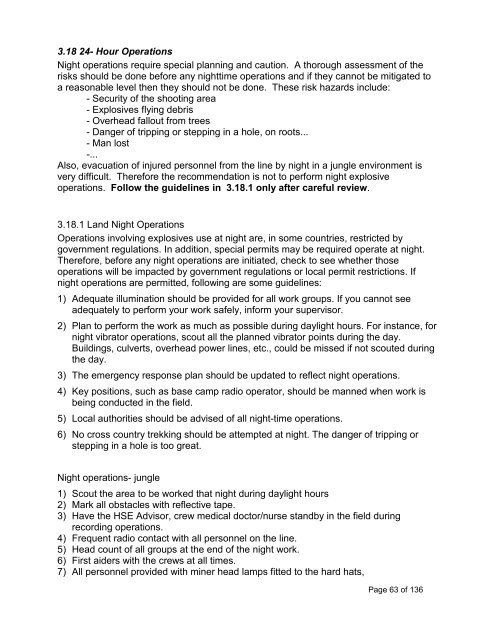IAGC LAND GEOPHYSICAL SAFETY MANUAL Edition 9 ... - CGISS
IAGC LAND GEOPHYSICAL SAFETY MANUAL Edition 9 ... - CGISS
IAGC LAND GEOPHYSICAL SAFETY MANUAL Edition 9 ... - CGISS
- No tags were found...
Create successful ePaper yourself
Turn your PDF publications into a flip-book with our unique Google optimized e-Paper software.
3.18 24- Hour OperationsNight operations require special planning and caution. A thorough assessment of therisks should be done before any nighttime operations and if they cannot be mitigated toa reasonable level then they should not be done. These risk hazards include:- Security of the shooting area- Explosives flying debris- Overhead fallout from trees- Danger of tripping or stepping in a hole, on roots...- Man lost-...Also, evacuation of injured personnel from the line by night in a jungle environment isvery difficult. Therefore the recommendation is not to perform night explosiveoperations. Follow the guidelines in 3.18.1 only after careful review.3.18.1 Land Night OperationsOperations involving explosives use at night are, in some countries, restricted bygovernment regulations. In addition, special permits may be required operate at night.Therefore, before any night operations are initiated, check to see whether thoseoperations will be impacted by government regulations or local permit restrictions. Ifnight operations are permitted, following are some guidelines:1) Adequate illumination should be provided for all work groups. If you cannot seeadequately to perform your work safely, inform your supervisor.2) Plan to perform the work as much as possible during daylight hours. For instance, fornight vibrator operations, scout all the planned vibrator points during the day.Buildings, culverts, overhead power lines, etc., could be missed if not scouted duringthe day.3) The emergency response plan should be updated to reflect night operations.4) Key positions, such as base camp radio operator, should be manned when work isbeing conducted in the field.5) Local authorities should be advised of all night-time operations.6) No cross country trekking should be attempted at night. The danger of tripping orstepping in a hole is too great.Night operations- jungle1) Scout the area to be worked that night during daylight hours2) Mark all obstacles with reflective tape.3) Have the HSE Advisor, crew medical doctor/nurse standby in the field duringrecording operations.4) Frequent radio contact with all personnel on the line.5) Head count of all groups at the end of the night work.6) First aiders with the crews at all times.7) All personnel provided with miner head lamps fitted to the hard hats,Page 63 of 136
















